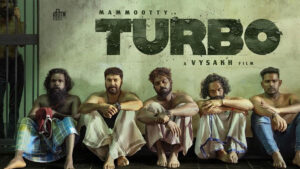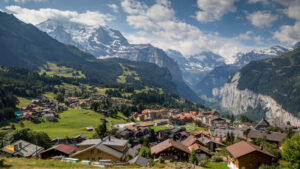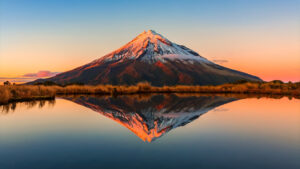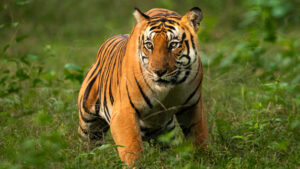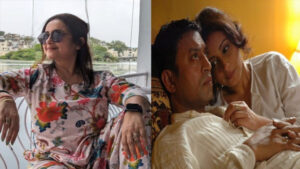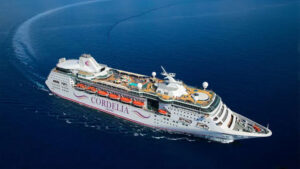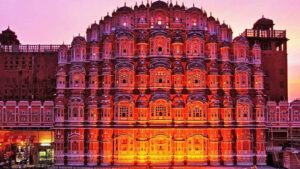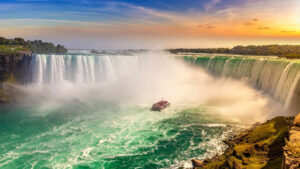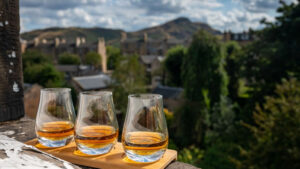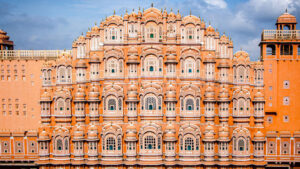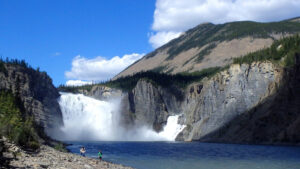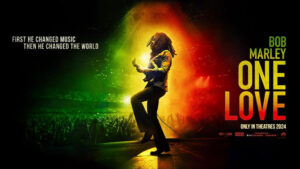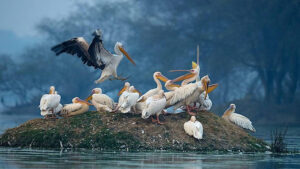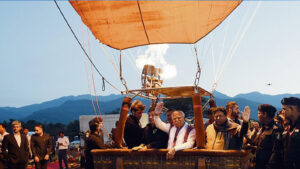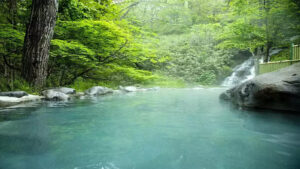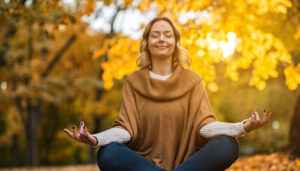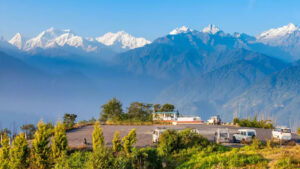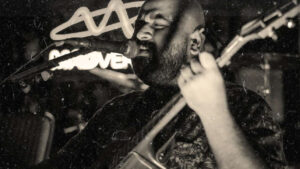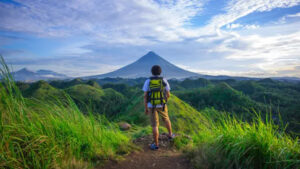THE GRAND PALACE, BANGKOK – STEP INTO MAJESTY AND DISCOVER THE GRANDEUR

The Grand Palace in Bangkok, Thailand, stands as a captivating testament to the country’s rich cultural heritage and architectural splendor. Located in the heart of the bustling city, this iconic complex is a magnificent symbol of Thailand’s monarchy and a must-visit destination for travelers. Built in the late 18th century, the Grand Palace served as the official residence of Thai kings for over 150 years. With its intricate detailing, vibrant colors, and awe-inspiring structures, the Grand Palace is not only a historical marvel but also a spiritual and cultural center that showcases the country’s deep-rooted traditions. It is home to the revered Temple of the Emerald Buddha and several other opulent halls and buildings that mesmerize visitors with their grandeur. Stepping into the Grand Palace is like entering a world of regal elegance, where the past seamlessly blends with the present, leaving visitors in awe of Thailand’s rich artistic heritage and royal legacy.

Overview
- Historical Significance: Built in 1782, the Grand Palace served as the official residence of the Kings of Siam (now Thailand) for over 150 years. It not only served as a royal residence but also as the administrative and ceremonial center of the Thai monarchy.
- Architectural Marvel: The Grand Palace is renowned for its exquisite architecture, blending traditional Thai elements with influences from other Southeast Asian architectural styles. The complex features intricate detailing, vibrant colors, and gilded structures that showcase the craftsmanship and artistic prowess of Thai artisans.
- Museum and Exhibitions: Within the complex, there are museums and exhibitions that provide insights into the history, art, and culture of Thailand. Visitors can explore artifacts, royal regalia, and historical objects that offer a deeper understanding of the country’s rich heritage.
- Dress Code: As the Grand Palace is a revered and sacred site, visitors are required to dress modestly. Both men and women must cover their shoulders and knees. Sarongs and shawls are available for rent at the entrance for those who need appropriate attire.
The Grand Palace stands as a testament to Thailand’s royal legacy and artistic brilliance. Its stunning architecture, sacred temples, and historical significance make it a must-visit destination for travelers seeking a glimpse into the grandeur of Thai culture and history.
Inside the Palace
Within the expansive grounds of the Grand Palace in Bangkok, visitors can explore a myriad of captivating structures, temples, and halls that provide a glimpse into Thailand’s rich history, art, and culture. Here are some notable highlights of the Grand Palace’s interior:

- Wat Phra Kaew (Temple of the Emerald Buddha): This revered temple within the Grand Palace houses the highly venerated Emerald Buddha, a small and meticulously carved statue of the Buddha from a single piece of jade. The statue, adorned with different seasonal robes, is situated atop an elevated platform and surrounded by gilded decorations and mural paintings depicting scenes from Buddhist mythology.
- The Phra Maha Monthian Group: This group of buildings consists of royal residences and halls that were used for important ceremonial occasions. The most prominent among them is the Chakri Maha Prasat Hall, an elegant structure blending European and Thai architectural styles. It features a central spire and a beautifully adorned reception hall where significant events, such as royal coronations, took place.
- The Amarindra Vinichai Hall: This majestic hall, characterized by its traditional Thai architecture, served as the residence of King Rama I. It features intricate mural paintings depicting episodes from the Hindu epic Ramayana and offers a glimpse into the artistic prowess of Thai artisans.
- Phra Thinang Chakri Maha Prasat: This is the primary throne hall of the Grand Palace and serves as the official residence of the Thai monarchs. Its unique architectural style blends elements of European neoclassical design with traditional Thai influences, creating a grand and elegant setting.
- The Royal Pantheon (Prasat Phra Thep Bidon): This small but striking structure is dedicated to the Chakri dynasty’s past kings and queens. Inside, you’ll find life-sized statues of the royal ancestors, paying tribute to their contributions and legacies.
Throughout the complex, visitors will be captivated by the intricate architectural details, vibrant colors, and exquisite craftsmanship that adorn the buildings. The interior spaces are often filled with historical artifacts, royal regalia, and stunning works of art that further immerse visitors in the grandeur and cultural richness of the Thai monarchy.
Other Top Attractions Nearby
In addition to the Grand Palace, Bangkok offers a plethora of top attractions in its vicinity that are worth exploring. Here are some notable attractions nearby:

- Wat Arun (Temple of Dawn): Located on the banks of the Chao Phraya River, Wat Arun is an iconic temple known for its stunning architecture and intricate details. The temple’s towering spires, adorned with colorful porcelain, create a mesmerizing sight, especially during sunrise or sunset.
- Wat Pho (Temple of the Reclining Buddha): Just a short distance from the Grand Palace, Wat Pho is famous for its massive reclining Buddha statue, which measures 46 meters long and is covered in gold leaf. The temple complex also houses numerous beautiful chedis (stupas) and is known as a center for traditional Thai massage.
- Wat Benchamabophit (Marble Temple): This elegant temple, constructed with white Italian marble, showcases a blend of Thai and European architectural styles. It is renowned for its tranquil atmosphere, beautiful gardens, and a large collection of Buddha images.
- Jim Thompson House: A unique cultural attraction, the Jim Thompson House showcases traditional Thai architecture and houses an extensive collection of Southeast Asian art and antiques. The house belonged to Jim Thompson, an American entrepreneur who played a significant role in reviving the Thai silk industry.
- Chatuchak Weekend Market: One of the largest markets in the world, Chatuchak offers a vibrant shopping experience with thousands of stalls selling a wide variety of goods, including clothing, handicrafts, accessories, and delicious street food. It’s a great place to explore and experience the vibrant local culture.
- Chao Phraya River and Canal Tours: Embarking on a boat tour along the Chao Phraya River or the historic canals (klongs) provides a unique perspective of Bangkok. Visitors can enjoy picturesque views of the city’s landmarks, floating markets, and local riverside life.
- Khao San Road: Known as the backpacker hub of Bangkok, Khao San Road offers a lively atmosphere with bustling street markets, vibrant nightlife, and a range of budget accommodations. It’s a popular spot for travelers looking for a fun and energetic experience.
Shopping and Must Try Cuisine
Bangkok offers a diverse range of shopping experiences, from bustling street markets to modern shopping malls. Additionally, the city is known for its delectable cuisine, which showcases a tantalizing mix of flavors and influences. Here are some top shopping destinations and must-try cuisines in Bangkok:
Shopping:
- Chatuchak Weekend Market: One of the largest markets in the world, Chatuchak offers an immense variety of goods, including clothing, accessories, home decor, handicrafts, and more. It’s a shopper’s paradise with over 8,000 stalls spread across 27 sections.
- Pratunam Market: Known as a wholesale market, Pratunam is famous for affordable clothing, textiles, and fashion accessories. It’s a great place to find trendy and fashionable items at reasonable prices.
- MBK Center: This bustling shopping mall in the heart of Bangkok offers a mix of shops, boutiques, electronics, fashion, and more. It’s a popular destination for both locals and tourists seeking a wide range of products.
- Siam Paragon: Considered one of Bangkok’s most luxurious shopping malls, Siam Paragon houses high-end designer brands, luxury goods, gourmet food, and a massive cinema complex. It’s a destination for upscale shopping and indulgence.
- Asiatique The Riverfront: Situated by the Chao Phraya River, Asiatique is a unique shopping and entertainment complex built within a refurbished warehouse. It offers a blend of boutique shops, restaurants, bars, and a night market, providing a charming riverside experience.

Must-Try Cuisine:
- Pad Thai: This iconic Thai dish consists of stir-fried rice noodles with shrimp, chicken, tofu, or vegetables, flavored with tamarind sauce, fish sauce, peanuts, lime, and chili.
- Tom Yum Goong: A quintessential Thai soup, Tom Yum Goong is a spicy and sour soup made with shrimp, lemongrass, galangal, lime leaves, chili, and other aromatic herbs. It’s bursting with flavors and is incredibly popular.
- Green Curry: Known as “Gaeng Keow Wan,” this flavorful curry is made with a paste of green chilies, Thai basil, coconut milk, and various herbs and spices. It is often enjoyed with rice and a choice of meat or vegetables.
- Mango Sticky Rice: A popular Thai dessert, Mango Sticky Rice features ripe mangoes served with sweet coconut-infused sticky rice. It’s a delightful combination of flavors and textures.
- Som Tam (Papaya Salad): A refreshing and spicy salad made with shredded green papaya, tomatoes, peanuts, lime juice, fish sauce, and chilies. It’s a popular street food dish that packs a punch.
- Thai Iced Tea: A sweet and creamy beverage made with black tea, condensed milk, and often topped with ice. It’s a refreshing and popular choice to complement spicy Thai dishes.
Best Time to Visit
The best time to visit Bangkok, considering weather, events, and festivals, can vary based on individual preferences. Here’s a breakdown of different seasons and their corresponding highlights:
- Cool Season (November to February): This is generally considered the best time to visit Bangkok. The weather is relatively cooler and drier, with temperatures ranging from 20 to 30 degrees Celsius (68 to 86 degrees Fahrenheit). It is ideal for outdoor activities and exploring the city’s attractions. Additionally, this period coincides with the festive holiday season, including Christmas and New Year, which adds a vibrant atmosphere to the city.
- Loy Krathong (November): Loy Krathong is a significant festival in Thailand, where people release beautifully decorated floating lanterns and small boats onto rivers and waterways. Bangkok comes alive during this festival, offering a magical experience. The exact dates vary each year, so it’s advisable to check the festival schedule in advance.
- Songkran (April): Songkran, the Thai New Year celebration, is known for its water festival. Bangkok becomes a lively hub of water fights and festivities as people splash water on each other to symbolize washing away the old year and welcoming the new one. The dates for Songkran are fixed, starting on April 13th and lasting for several days.
- Vegetarian Festival (September/October): Bangkok’s Chinatown hosts a vibrant Vegetarian Festival, known as the Nine Emperor Gods Festival. During this period, participants observe a strict vegetarian diet and engage in various rituals and processions. It’s a unique cultural experience with colorful parades and street stalls offering vegetarian delicacies.




